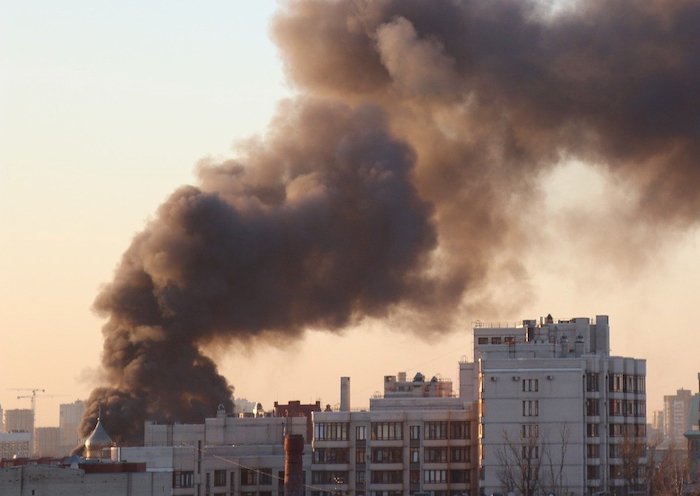
In this scenario a journalist lets their own emotional assumptions colour their news judgement resulting in misinformation.
A young radio reporter is coming to the end of his first month on the job. He’s just been approved to drive the radio station’s news car, which means he can now go out on stories and broadcast live from the scene. He’s very excited.
He looks out of the newsroom window and sees a thick plume of smoke rising from the east of the city centre. He alerts the news editor who agrees he should take the radio car, get as close to the scene as possible, and report live into the next bulletin at 4pm.
The reporter arrives at the scene at 3:50pm. He parks behind two fire engines at the corner of a building which is ablaze.
The reporter has 10 minutes before he has to go live into the bulletin. He tries to find someone for a comment, but all the firefighters are busy trying to control the flames, while the police are trying to control the crowd.
However, one of the engineers operating the fire engine pump will talk. When asked whether there are any casualties, he says “Not that we know of, but there are still people in the building.”
The reporter sees a group of people carrying items out of the burning tenements. He presumes they are trying to salvage what they can from the flames.
He lives in a similar part of the city and in similar accommodation. He feels sorry for them.
At that point he decides on the top line for his live report – that people are still in the building trying to salvage what possessions they can.
He hasn’t even considered that he could be at a crime scene where looters are stealing items as residents flee their burning homes.
He raises the radio car mast. The vehicle is new. It has the radio station’s logo plastered all over it in red, white, and blue. The reporter can see the car is attracting attention.
A group of men, some with their faces covered, gather round the vehicle. Three police officers approach and try to block their way.
By now the reporter is sitting in the radio car ready to broadcast. It’s one minute to the 4pm bulletin.
He leaves all four windows half-open to try to capture the sound effects of the chaos outside.
The 4pm news jingle starts to play.
The news reader announces that there is a major fire at a city centre tenement block. He then says, “We are now going live to our reporter on the scene.”
The light on the reporter’s microphone goes green. He’s live. He starts his report…
“The fire has now spread to four floors of this five-storey building. Dozens of firefighters are trying to contain the blaze. Residents are still in the building. Many are trying to salvage what they can from their burning homes. Working together they’re stacking their possessions on the street.”
One of the police officers, who had been protecting the radio car while the reporter was broadcasting, bangs on the window and shouts, “They’re looting, you’ve got to move, it’s not safe here.”
Emotions and assumptions take over
What we have here is a situation where an inexperienced reporter, faced with a breaking news story, is expected to report live from the scene with little knowledge of what is really going on.
That is a common situation.
But the reporter has been carried away with the excitement of the event, and, in the absence of any credible information, and with no time for proper news-gathering or fact-checking, relies solely on his own emotions and assumptions.
And that is not good.
The fact that he lived in a similar inner-city area meant that he was unable to be objective; he immediately assumed those gathering possessions were similar to his own neighbours.
His emotions were high when he thought they were salvaging what they could. He made a false assumption and that polluted his report.
The story he had built in his mind from the moment he arrived at the scene was wrong. Not only was it wrong, but it was missing the importance of the event.
He was witnessing rioting and looting, not local residents working together to salvage what they could from their burning homes.
In such situations reporters must detach themselves from events, broadcast what they see, and avoid any assumptions.
If they are unable to find out what is actually going on from a reliable source, they should offer a situation report about what they can see in front of them.
There was enough eye-witness material to fill a 30-second report without adding guesswork.
Guesswork, assumptions, and emotionally charged observations are not part of breaking news reporting.
The report should have been limited to describing the flames, the smoke, the number of fire engines, the size of the crowd, and the number of police at the scene.
The reporter’s mistake was letting his imagination take over.
He was broadcasting false information to the station’s listeners.
This was before social media, but in today’s age of Facebook and Twitter, such an error could lead to a rapid spread of misinformation which would take on a life of its own as raw emotion and ill-informed reaction is added.
Lessons from this scenario
- A breaking news reporter’s job is to describe what is happening at the scene, you are not there to interpret without evidence. If you have facts that are sourced and verified, you should include them.
- It doesn’t matter what you think might happen next. Guesswork about the future has absolutely no value.
- You must avoid all assumptions when compiling a report. Assumptions are fine when you are trying to work out what the story is during the research stage, but they then must be verified or discarded during the fact-checking process – they have no place in live situation reports.
- Adjectives and adverbs have little value in live breaking news reporting. The facts are strong enough on their own. The audience doesn’t need your subjective take on things, or your own personal value judgements.

This scenario vividly illustrates the dangers of emotional bias and unchecked assumptions in journalism, particularly in the fast-paced environment of breaking news.
Core problems:
- Emotional bias:
- The reporter’s personal experience living in a similar area clouded his judgement. He empathised too strongly, leading him to project his own feelings onto the situation.
- This emotional connection prevented him from objectively assessing the scene.
- Premature assumptions:
- He jumped to conclusions about the people removing items from the building, assuming they were salvaging possessions rather than looting.
- This assumption was based on his emotional bias, not on factual observation or verification.
- Lack of fact-checking:
- He failed to gather sufficient information from reliable sources. He relied on a brief, ambiguous statement from a fire engineer and his own assumptions.
- He did not consider alternative explanations for what he was witnessing.
- Prioritising narrative over accuracy:
- He constructed a narrative in his mind and then forced the facts to fit it, rather than letting the facts dictate the story.
- He was more concerned with creating a dramatic story, than telling the truth.
- Failure to report what he saw:
- Instead of simply describing the scene, he interpreted it, and incorrectly.
Key takeaways:
- The importance of objectivity:
- Reporters must strive to maintain objectivity, especially in emotionally charged situations.
- Personal experiences and feelings should not influence news judgement.
- Journalists need to examine their own unconscious bias.
- The necessity of verification:
- Assumptions must be rigorously checked and verified before being reported as fact.
- Multiple sources should be consulted to ensure accuracy.
- Fact-checking is essential.
- Descriptive reporting:
- In breaking news, especially when information is limited, descriptive reporting is crucial. Focus on what you can see and hear, without adding subjective interpretations.
- “Just the facts” is a powerful tool.
- The dangers of misinformation:
- Misinformation can spread rapidly, especially in today’s digital age.
- Reporters have a responsibility to be accurate and avoid contributing to the spread of false information.
- The power of words:
- Using adjectives and adverbs add subjective opinion. In breaking news, the facts alone carry the weight of the story.
- The pressure of live reporting:
- Live reporting is a high-pressure environment, but it does not excuse inaccurate reporting.
- Reporters must be trained to handle these situations responsibly.
- Ethical considerations:
- The reporter’s actions had ethical implications, potentially endangering the safety of himself and others, and misrepresenting the situation to the public.
- Journalistic ethics are essential.
In essence, this scenario serves as a cautionary tale about the importance of journalistic integrity, objectivity, and accuracy. It highlights the need for reporters to prioritize factual reporting over emotional narratives, especially in the chaotic and fast-paced world of breaking news.
Related articles








